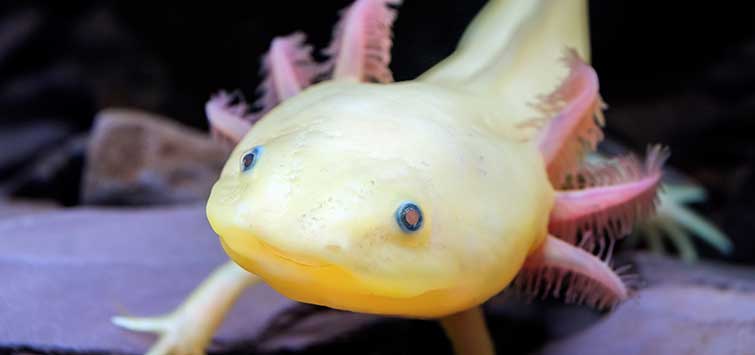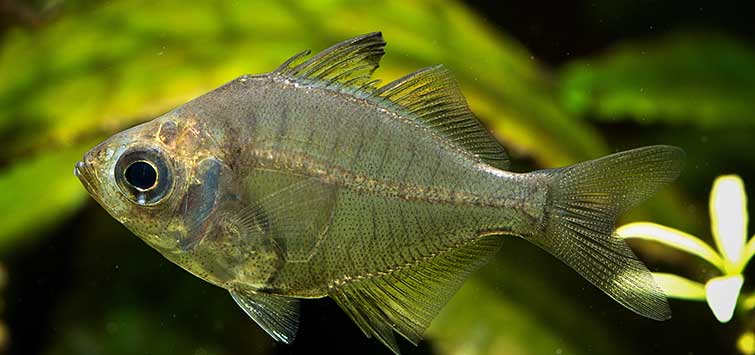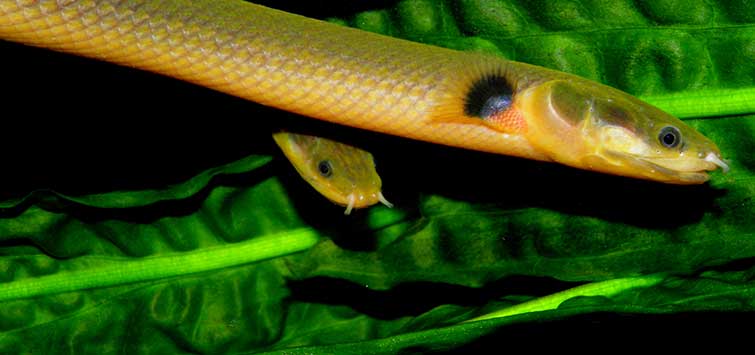The Axolotl: A Unique Option for the Aquarium
Author: Brian Robinson
If you’re looking for something different for the aquarium, the axolotl is sure to please with its otherworldly looks. Learn how to care for these animals so you can add one to your own home.
The One-of-a-Kind Salamander
The axolotl (Ambystoma mexicanum) is one of the most fascinating animals you can ever put in your aquarium. It is a neotenic salamander, meaning that it is sexually mature while still in the larval life stage and, therefore, never converts into the terrestrial form. Axolotls are native to Lakes Xochimilco and Chalco in Mexico; however, this already small native range is shrinking due to urbanization.
Fortunately, they reproduce relatively easily in captivity and have scientific value due to their ability to regenerate their external gills, tail, and even limbs. This has made them the subject of scientific research, leading to large captive populations and many color morphs. They can attain sizes of 12 inches or more and have a typical larval caudate body form with a salamander-type body, external gills, and a crest across their dorsal surface that continues into the tail. Healthy individuals will usually have a robust, thick build.
Special Considerations for Axolotls
Water Temperature Requirements
Captive care for these animals is relatively easy, but there are certain issues that are very important to their long-term health. One of the most important issues when it comes to axolotl care is temperature. Axolotls are truly cool-water animals and are, therefore, stressed by higher temperatures. It may seem odd that these animals are from Mexico and yet are so intolerant of heat. This is because the lakes they are from are at higher altitudes and, therefore, are cooler than low-altitude climates of the same latitude. Temperatures above and around 75°F will be very stressful, and any extended period of time at this temperature can quickly lead to illness and death.
Temperatures below 70° are ideal, and those between 70° and 74° can become problematic, though they can be managed. The warmer the water is, the less oxygen it can hold. Because of this, the warmer an axolotl aquarium is, the more important aeration and oxygen levels become. Adequate aeration can make the difference between healthy and unhealthy axolotls in this borderline temperature range.
Substrate
Another important issue that is frequently overlooked is the substrate. In most aquariums, the color, texture, and size of the substrate are all simply a matter of taste, but since axolotls do not simply swim around, it becomes much more important. Bare-bottom aquariums are not ideal for axolotls because they do not provide them with anything to grip. This can cause unnecessary stress and even sores on the end of their toes.
Gravel is also not ideal because it can be easily swallowed and lead to an impaction that they may not be able to pass. I mistakenly kept the first axolotls I ever owned on gravel. Once I did enough research to realize my mistake, I moved them to a more appropriate setup. Within a few days, there were pieces of gravel they brought with them from their original tank in their digestive system. They were lucky to not have any major health issues because of my mistake, but many are not so lucky.
The ideal substrate for axolotls is sand. It can pass through even small individuals without any issues and provides them with something to comfortably grip as they roam through their aquarium.
Tankmates
Compatibility is a frequently debated topic when it comes to any aquatic animal, and axolotls are no exception. Most axolotl keepers keep them with no other types of animals for a few reasons. Number one is that their external gills and slow nature simply make them an easy target for fish. Even slow fish find the flowing external gills too tempting and will make a meal out of them, frequently leaving the axolotls with no more than nubs of what were once large, full gills.
Another issue is that axolotls are nocturnal and can make an easy meal of sleeping fish in the middle of the night. It is almost impossible to find an acceptable tankmate that is neither too small to be eaten nor aggressive enough to make a meal of the axolotl’s gills (or the whole axolotl).
The only fish I have ever had work well at all with axolotls are fancy goldfish. They are very slow, and if well fed, many individuals will not put the effort into going after the axolotls. Mine would get too close to the axolotls, get nipped at, and then learn to stay away from them. However, even with fancy goldfish there is no guarantee, so the safest thing to do is keep axolotls to a species-only tank. Axolotls can pose a serious risk to each other as well. Small and young axolotls are easy targets for larger individuals and can simply be eaten or lose limbs. Overcrowding of similar-sized individuals can also lead to missing limbs or dead ones. It is important to mix only individuals of similar size and only with adequate space.
Feeding
Feeding axolotls is fairly straightforward: They are highly carnivorous and prefer meaty foods. The size of the food offered will vary according to the animal’s size. High-quality pellets can provide a well-balanced diet, and trout and salmon pellets of appropriate size are one of the most popular options. High-quality sinking foods for carnivorous fish are another popular option. In addition to these, many people rely on a variety of strips of meat and fish, frozen foods, live foods, chopped earthworms, and other similar foods. Just like with fish, it is important to feed appropriate amounts because any uneaten food will rot and lower water quality.
Tank Setup
Aquarium setup is largely a matter of preference, but there are certain issues that need to be kept in mind. Very young and small individuals can be kept in standard 10-gallon aquariums. Adults need to be in larger tanks; a 20-long would be a minimum for one to two individuals. An additional 10 gallons per individual would be an acceptable guide if more than two are to be kept in the same tank.
Lighting
They are nocturnal, so bright lighting with few or minimal hiding places will be stressful. They prefer to have areas to hide in during the day. These can consist of almost anything that provides shelter: PVC pipes, hollow ceramic aquarium decorations, stacked rock, and even the hollow ceramic rocks used for cichlids make great hiding spots for axolotls. Other decorations are optional, but anything in the tank should be smooth without any potentially hazardous sharp points or rough edges. There should be more hiding places than individuals in the tank. This will allow them to avoid each other and can help prevent aggressive behavior that could lead to stress, missing limbs, and even death.
Filtration
Filtration can be a little tricky for axolotls since some of the rules for fish do not apply well to axolotls. Axolotls prefer slow-moving water and high flow can prove to be too stressful. Obviously, adequate filtration to keep the tank clean is essential for water quality and health, but the flow must be kept relatively low. Sponge filters are a great option because they provide very effective filtration while creating relatively low flow compared to many power filters and pumps. They are also good because they help increase aeration and oxygen levels.
If other filters are used, it is important to make sure that the axolotls cannot become stuck to the intake and that the filter does not create too much flow. Stress from high flow can be evidenced by the axolotls holding their gills curved forward more than usual.
Water Changes
Water changes should be carried out just like they are on any other aquarium. High water quality is just as essential to the long-term success of axolotls as it is to any fish. A good routine of weekly partial water changes will help avoid many of the problems that may otherwise arise.
Available Color Morphs
One of the most attractive aspects about axolotls is the wide array of color morphs they are available in. There are wild types that have a gray to dark-olive base with dark gray to black spots. There is also melanistic, a solid pattern available in gray or black.
Albino
There are two forms of albino available, white and gold. The white is an even-colored white with pink eyes, and the gold is similar to the white except for gold or yellow blotches covering almost all of the body. Leucistic is similar to white albino, except they have black eyes and may have a dusting of black on the body.
Piebald
One of the most attractive forms that is almost impossible to find is the piebald, a white base with large black blotches. With the darker-colored morphs, older individuals may develop small yellow or gray spots, almost like age spots.
GFP
They have recently developed lines with green fluorescent proteins. These are genetically modified to have pigments that glow green under black lights. The green fluorescent protein (GFP) is independent of other colors, so you may find them available as GFP wild type, GFP white albino, etc.
Breeding Axolotls
Breeding axolotls is relatively easy. Mature individuals can be sexed easily, as males will have a swollen cloaca, or vent, while females will have a smoother and less pronounced cloaca.
Breeding may be triggered accidentally if they are kept in a basement or other room that varies in temperature throughout the year. This can also be done artificially by shortening the photoperiod while simultaneously slightly raising the temperature followed by bringing the temperature back down and increasing the photoperiod again. Some prefer to keep the pair separate during this time and then introduce them to a different, cooler tank for breeding.
Once triggered to breed, the male will deposit spermatophores, small packets of sperm, which the female will pick up with her cloaca (with a helpful nudge in the right direction by the male). Later she will lay the fertilized eggs on plants (real or fake). At this point the eggs should be moved to a rearing tank if they were laid in the display tank, or the adults should be removed if they were put in a tank set up specifically for breeding.
After two to three weeks (dependent on temperature), the eggs will hatch and the offspring should be treated like fish fry. They require small live foods like daphnia and brine shrimp. As they grow, their food should change to fit their growing mouths and bodies until they are miniature adults ready to be sold. During this entire time, water quality is vital, just as it is when breeding and raising fish.
A Truly Unique Aquarium
If you’re willing to devote an aquarium to axolotls and you can meet their unique needs, I highly recommend getting some. They are quite fascinating, and almost anyone (with an interest and knowledge of fish or not) will notice and be amazed by these creatures.
See the full article on TFH Digital http://www.tfhdigital.com/tfh/201210#pg63

.png?h=595&iar=0&w=2781&hash=5FD5E69473BCC22199FBFA2FB71B6033)



